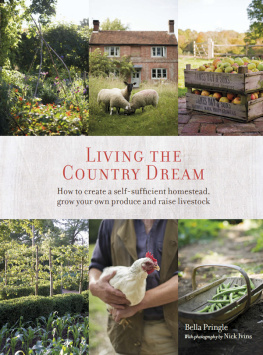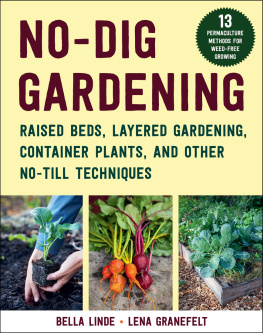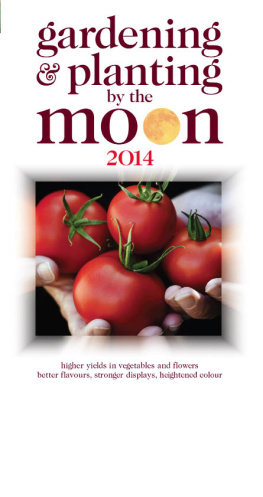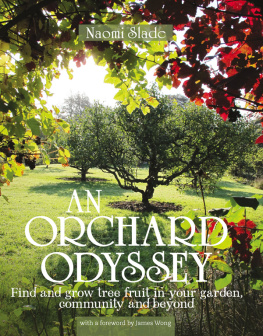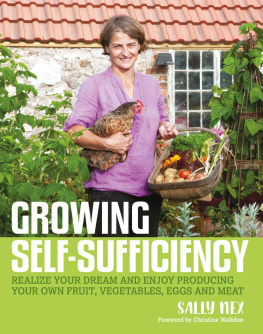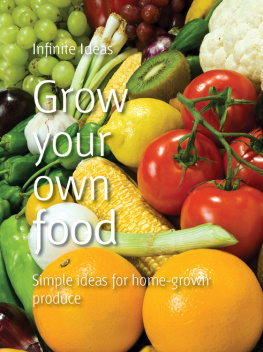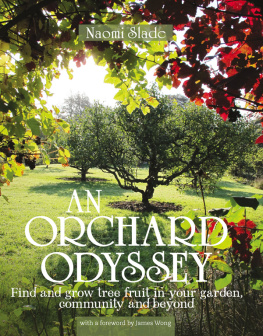Living the Country Dream

Living the Country Dream
How to create a self-sufficient homestead, grow your own produce and raise livestock
Bella & Nick Ivins
With photography by


First published in 2016 as
The New Homesteader.
This edition published in 2021 by Ryland Peters & Small
2021 Jockeys Fields,
London WC1R 4BW
and
341 East 116th Street,
New York NY 10029
www.rylandpeters.com
10 9 8 7 6 5 4 3 2 1
Text Bella and Nick Ivins 2016, 2021
Design Ryland Peters & Small 2016, 2021
Photography Nick Ivins 2016, 2021
ISBN: 978-1-78879-355-1
E-ISBN: 978-1-78879-399-5
Printed and bound in China
The authors moral rights have been asserted. All rights reserved. No part of this publication may be reproduced, stored in a retrieval system or transmitted in any form or by any means, electronic, mechanical, photocopying or otherwise, without the prior permission of the publisher.
A CIP record for this book is available from the British Library.
US Library of Congress Cataloging-in-Publication Data has been applied for.
Senior Designer Toni Kay
Senior Commissioning Editor Annabel Morgan
Head of Production Patricia Harrington
Art Director Leslie Harrington
Editorial Director Julia Charles
Publisher Cindy Richards

Contents




Introduction

Over the ten years we have spent here at Walnuts Farm, we have developed a system of food production that suits us as well as the land we farm. Our aim as homesteaders is to raise just the right amount to feed our little family and any visiting friends, but no more. We dont aim for a surplus or to sell produce at a profit. It is also important to point out that we are not 100 per cent self-sufficient or purist about trying to be so. We admire those homesteaders who are both, but for us it is simply a question of growing what we like to eat, is expensive to buy or tastes best fresh from the garden. We are not ashamed to head to the grocery store, a local farm shop or even the supermarket to augment our produce. You could perhaps call us fair-weather farmers, in that we aim to put in the least effort for maximum enjoyment and optimal production from the resources we have available.
When we started out, we soon discovered that to succeed as homesteaders, its essential to work with what youve got rather than fight against it. Walnuts Farm is situated on heavy clay and poor and unimproved grazing land. Because of the wet conditions over winter, we can only rear livestock outdoors during the summer months. For us, therefore, most of our homesteading activities take place in this season. We do less farming in the winter months and more hunting for game foods. Winter is also a time to warm by the fireside, to rest, take stock and plan for the year to come.
In this book, we hope to show how you too can make a virtue of necessity, whatever the scope of your enterprise. And also to prove that the good life does not have to be the hard life. Whether you farm on a microscale in an urban backyard or suburban garden, or upon several rural acres, or even if the notion of homesteading is still a dream rather than a reality, we hope that our experiences, successes and failures will be of interest. If your desire is to become totally self-sufficient, then our method of homesteading offers an easy way in and a place from which to expand.
We decided from the start that everything at Walnuts Farm has to feed the eye as well as the family, for our aim is to gain as much pleasure from the doing as from the final result. We are conscious that our homesteading is to some extent a labour of love and as such must reward us in every way. This is not, for us, a luxury. With every activity we have an opportunity to do it well and to find an elegant design solution, or to merely do it adequately, at a cost to the environment and to aesthetics.
On our homestead, we have several different enterprises separated into distinct zones. Adjacent to the house, the kitchen garden is at the heart of the enterprise. We find that it is best positioned close to the house as we work in it little and often, sowing, growing and harvesting throughout the year. Surrounding this are areas for pigs, sheep, bees and poultry, on the meadows and among the woodland. These enterprises require less of our labour so can be positioned a little further from the house.
Despite what non-gardening visitors may think, our kitchen garden is relatively easy to manage. Most of our fruit and vegetable production takes place on less than an acre. We do not dig our beds as were on clay, and in our experience this is best left below ground and not brought to the surface. But our growing beds are big approximately 7.5 x 7.5m/25 x 25ft each. Between them we have laid hard-wearing gravel paths that fit a wide wheelbarrow, and the central axis will accommodate a Land Rover plus trailer. We dont try to extend the growing season at either end, as we have limited resources and no polytunnel. Accordingly, we outsource some early seed-growing to a friends commercial glasshouses nearby, and this gives us a head start on the growing year.


When we are tilling the ground, we have to work efficiently. We use a big cultivator hoe for weeding and so we plant rows to fit the width of the cultivator. We use few other tools and spend little time watering as we are growing for flavour, not volume. We do spend time on defence keeping rabbits and deer out, as well as mice and slugs but at least we can harvest some of these pests for the kitchen table.
We introduce pigs and lambs as young stock in spring, when the land dries out, and fatten them up over summer, using as much home-grown grass and feed as possible. They are all in the freezer by the time the land becomes wet again in autumn. The animals have complemented the vegetable and fruit production and integrated well with it, as well as providing interest and pleasure both in everyday life and on the plate. If we started over again, we would use pigs and chickens to do more of the site-clearing, and integrate the pigs directly into the rotation of beds in the kitchen garden to prepare the beds for cultivation.

